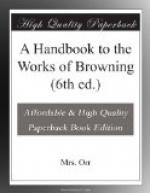The EPILOGUE is spoken by three different persons, and embodies as many phases of the religious life. The “FIRST SPEAKER, as David,” represents the old Testament Theism, with its solemn celebrations, its pompous worship, and the strong material faith which bowed down the thousands as one man, before the visible glory of the Lord.
The “SECOND SPEAKER, as Renan” represents nineteenth-century scepticism, and the longing of the heart for the old belief which scientific reason has dispelled. This belief is symbolized by a “Face” which once looked down from heights of glory upon men; by a star which shone down upon them in responsive life and love. The face has vanished into darkness. The star, gradually receding, has lost itself in the multitude of the lesser lights of heaven. And centuries roll past while the forsaken watchers vainly question the heavenly vault for the sign of love no longer visible there.
This lament assumes that Theism, having grown into Christianity, must disappear with it; and the pathetic sense of bereavement gives way to shuddering awe, as the farther significance of the sceptical position reveals itself. Man becomes the summit of creation; the sole successor to the vacant throne of God.
The “THIRD SPEAKER,” Mr. Browning himself, corrects both the material faith of the Old Testament, and the scientific doubt of the nineteenth century, by the idea of a more mystical and individual intercourse between God and man. Observers have noted in the Arctic Seas that the whole field of waters seem constantly hastening towards some central point of rock, to envelope it in their playfulness and their force; in the blackness they have borrowed from the nether world, or the radiance they have caught from heaven; then tearing it up by the roots, to sweep onwards towards another peak, and make it their centre for the time being. So do the forces of life and nature circle round the individual man, doing in each the work of experience, reproducing for each the Divine Face which is inspired by the spirit of creation. And, as the speaker declares, he needs no “Temple,” because the world is that. Nor, as he implies, needs he look beyond the range of his own being for the lost Divinity.
“That
one Face, far from vanish, rather grows,
Or decomposes
but to recompose,
Become my
universe that feels and knows!” (vol. vii. p.
255.)
“FEARS AND SCRUPLES” illustrates this personal religion in an opposite manner. It is the expression of a tender and very simple religious feeling, saddened by the obscurity which surrounds its object, and still more by the impossibility of proving to other minds that this object is a real one. It is described as the devotion to an unseen friend, known only by his letters and reported deeds, but whom one loves as by instinct, believes in without testimony, and trusts to as accepting the allegiance of the smaller being, and sure sooner or later to acknowledge




